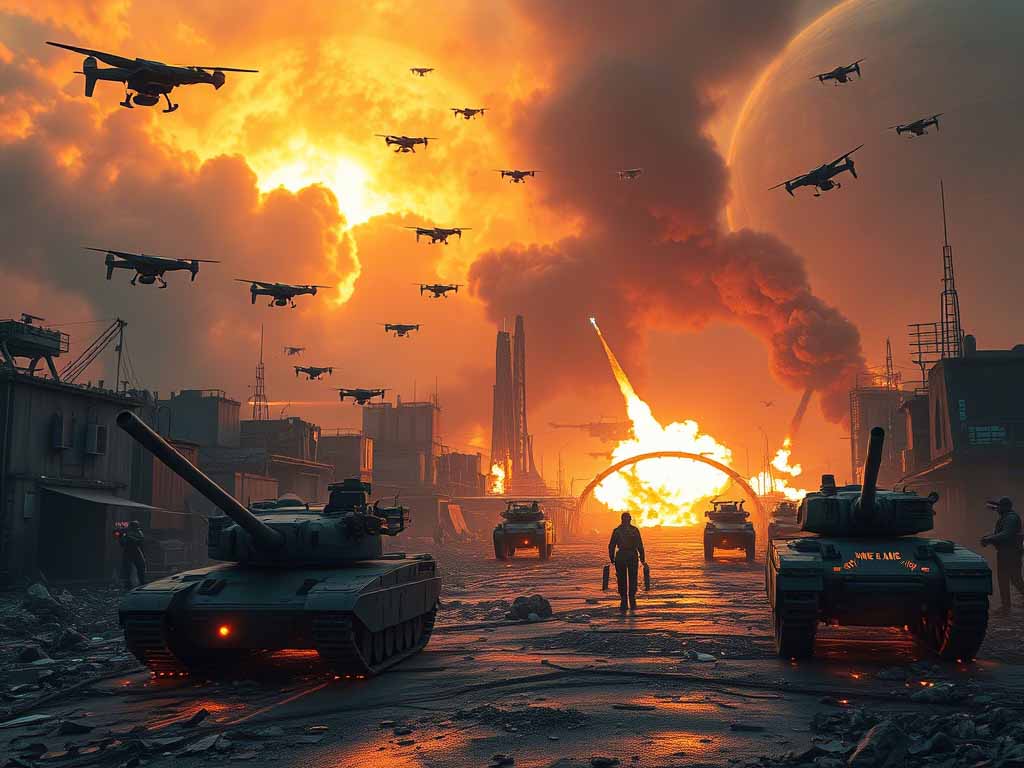The Digital Battlefield Is Already Here
A few decades ago, war meant tanks rolling through streets, soldiers in trenches, and planes roaring overhead. But today’s conflicts are shaped by something far less visible — data, algorithms, and machines learning to think for themselves.
Artificial intelligence is no longer just powering our phones and shopping apps. It’s increasingly embedded in military strategy, reshaping how wars are fought, planned, and, perhaps one day, avoided. This isn’t about robots with guns — not exactly. It’s about faster decisions, smarter systems, and, if we’re not careful, letting machines do too much of the thinking.
AI in the Military: Not Just an Experiment Anymore
Let’s be honest — AI in war sounds like science fiction. But if you look closely, it’s already here.
Across the world, defense agencies are putting AI to work in real missions. And no, it’s not just experimental lab stuff. This tech is out there in the field.
Take image recognition, for example. AI can scan drone footage or satellite images much faster than any human team — and often with surprising accuracy. In seconds, it can flag a suspicious vehicle or identify movement that might signal an ambush.
Autonomous vehicles, too — from drones to self-navigating boats — can now operate with little or no human guidance. Some are used for surveillance, while others are tested for more advanced missions.
And then there’s cyber warfare. Here, AI doesn’t just detect attacks. It can respond in real time, plugging holes, tracing hackers, and sometimes even launching digital countermeasures.
What’s more? Generals and military analysts use AI to simulate war scenarios — running millions of possibilities to decide how and when to act. In that sense, war isn’t just being fought with AI. It’s being shaped by it.
Should AI Be Allowed to Kill?
This question isn’t theoretical anymore. It’s the elephant in the war room.
Autonomous weapons — or “killer robots” as critics call them — are weapons that can find, track, and strike targets without a human pressing the button.
Some see them as the future: faster, more accurate, and less emotional than human soldiers. Advocates claim AI could reduce civilian casualties by acting with machine precision.
But the risks? Enormous.
What happens if the system misidentifies a civilian as a threat? Who takes the blame — the programmer, the military, or the machine itself?
This is why human rights groups, the UN, and thousands of scientists are calling for strict regulations — or even outright bans — on fully autonomous weapons. The world isn’t quite ready to hand over life-or-death decisions to a line of code.
The Speed of AI — A Blessing and a Curse
AI makes decisions fast. Scary fast. In military operations, where seconds matter, that’s often seen as a good thing.
But speed can be dangerous, too.
Imagine this: An AI detects what it believes is a missile launch from another country. It sends a warning. Another system, acting on the same data, prepares a counterattack. Humans have seconds to override — or it’s game over.
This kind of scenario, once fictional, now feels uncomfortably plausible. During military simulations, AI systems have already recommended actions that human officers later judged too risky or aggressive.
Speed is powerful. But when machines act faster than our ability to evaluate them, we lose control.
Real-World Conflicts, Real-World AI
If you think all this is just theory, think again.
In Ukraine, drones equipped with object-recognition AI have been used to locate targets more precisely. AI translation tools are helping interpret intercepted communications in real time.
In the Israel–Hamas conflict, AI reportedly plays a role in prioritizing intelligence and tracking the movement of suspected threats.
Meanwhile, U.S. military projects like Project Maven train AI to sift through video and satellite imagery to identify insurgents or high-risk patterns.
In each of these cases, AI isn’t replacing soldiers — but it is becoming a frontline force in decision-making.
The Ethics of Machines at War
It’s one thing to use AI to scan maps or fly a drone. But should it decide who lives and who dies?
War is messy. It’s emotional. It’s human. Machines don’t understand the gray areas. They follow data. And while that might sound efficient, it can lead to dangerous mistakes.
International law — like the Geneva Conventions — sets boundaries around war. But can AI recognize those boundaries? Can it tell a combatant from a civilian, a threat from a tool?
If it can’t, then what happens when a strike goes wrong?
Until we answer these questions clearly, we risk creating a future where accountability is lost and tragic mistakes are dismissed as “technical failures.”
The Rise of AI-Powered War Games
Not all uses of AI in the military involve live combat. Behind the scenes, AI is reshaping how armies train and plan.
Modern military forces run war simulations using AI to model potential threats — from cyberattacks to biological warfare. These war games help leaders understand vulnerabilities and test responses to scenarios too dangerous to try in real life.
The advantage? Scale and speed. AI can run thousands of “what-if” situations in a single afternoon — far more than any human planner could. This gives militaries a strategic edge, but also a new kind of arms race: a race for smarter predictions and preemptive planning.
AI for Peacekeeping?
Here’s a twist: AI might not only shape how wars are fought — it could help prevent them.
Think about this:
- AI can scan social media and other online behavior to predict unrest before it explodes into violence.
- It can monitor ceasefire lines via satellite, flagging violations in near real-time.
- It can track illegal arms shipments or coordinate rapid disaster responses better than human systems.
Used wisely, AI could support peacekeeping missions, protect civilians, and give humanitarian groups better tools to work with.
In short, the same AI that powers weapons can also power hope — if we choose to point it in that direction.
Final Thoughts: Who’s in Control?
So, is AI changing the future of war?
Absolutely. From how intelligence is gathered to how battles are fought — and even how peace might be maintained — AI is becoming one of the most important tools in modern military arsenals.
But here’s the deal: it’s not just about what AI can do. It’s about what we let it do.
If we lose sight of that, if we hand over too much control without clear rules, we risk letting machines drive decisions that should always — always — belong to humans.
Let’s not wait until it’s too late to draw that line.
Want to Explore More Topics Like This?
Check out these related reads on UseAI.click:



